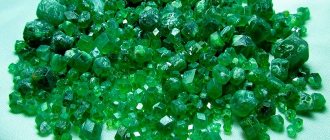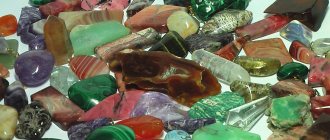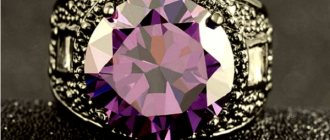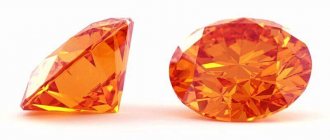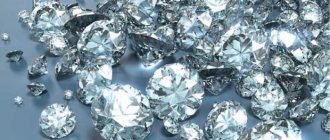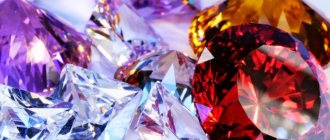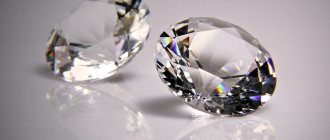In this article we will talk about the color of precious and semi-precious stones and the reasons for its occurrence. The information provided about the factors influencing the observed color and its components will help when buying or selling natural cut specimens and will be useful when evaluating. You will also learn the main reasons that cause the appearance of additional shades in gems. And information about the influence of a specimen’s color on its value can help in understanding the structure of the precious stones market.
In the photo: color varieties of the beryl mineral: aquamarine (blue), peachy pink morganite and golden yellow heliodor
Color is the most important characteristic of any stone. Of all the quality parameters, it is the color that most strongly influences the overall attractiveness and cost of the gemstone. Color is also an important diagnostic feature when identifying gems. The quality of colored natural jewelry stones is assessed by gemstone specialists - gemologists.
The main reason for the appearance of color
In the photo: top red ruby, 4.06 carats, Burma
The main reason for the appearance of color is the ability of the gemstone to selectively absorb light rays from the white light spectrum. The main components that shape a person’s perception of color are light, stone and the observer himself. White light contains all spectral components (i.e. all the colors of the rainbow).
Each color corresponds to a specific wavelength. When the light reaches the stone, part of the spectrum of white light is absorbed, and the totality of the light waves passing through the stone returns to the eye of the observer and causes the sensation that he sees. If a gemstone completely absorbs all wavelengths, it will appear black. If it completely reflects (or transmits) light, then it is perceived by the observer as white or colorless. A stone that absorbs light only at certain wavelengths appears to be a specific color to the observer.
Example
Let's look at this with an example. We perceive the color of a ruby as red, because... The stone absorbs green, blue and violet rays from light, and transmits only red, orange and yellow ones. When the rays passing through the ruby reach the eyes of the observer, the human brain combines them and interprets them as red.
Features of Kanny products
The Chinese manufacturer produces a complete set of products for applying gel polish. It includes a base, top (matte and glossy), color coating, as well as paints, primers, and other decorative elements. The advantages of Canni include, first of all, the best match between price and quality. Masters do not like to overpay for a brand if the quality of the gel polish is not in doubt.
Summer colors CANNI
Other advantages of using Kanni products:
- no unpleasant odor;
- comfortable brush made of natural bristles;
- dense consistency of the product;
- safe composition;
- versatility of use (can be used in combination with gel polishes from other manufacturers);
- high durability (up to 4 weeks without chipping);
- rich color palette.
Thanks to the ease of application, Canni gel polishes can be used even by beginners.
The influence of lighting and external factors on the observed color of the stone
The influence of lighting and external factors on the observed color of a mineral can be quite significant. The type of lighting itself (its color temperature) has a great influence on the color of the sample visible to the observer. So fluorescent lamps (white light) emit more blue, violet and green rays, which enhance the corresponding colors in the stones. And incandescent light (yellow light) contains more red, orange and yellow rays, so stones of the same colors will look better under that light. So for this reason, when selling red rubies, sellers often light the display case with lamps that produce yellow light, while the display case with blue sapphires will be illuminated by fluorescent lamps (white light). This factor of visual color enhancement depending on the type of lighting must be taken into account when purchasing stones. The standard lighting for color assessment is gemological lamps with daylight (365 nm).
On video: blue sapphire in different lighting. Incandescent light produces a purple tint
Healing qualities
You can restore order in the human body by treating individual areas with suitable minerals:
Pearl is an anti-stress, calming stone. Improves the condition of the eyes, kidneys, liver, relieves headaches and blood pressure.
Agate calms, relieves pain, cleanses the stomach and intestines. Moonstone is a friend of heart patients, protects against unstable nervous conditions, and is responsible for the gastrointestinal tract and genitourinary area.
Hematite, crushed into powder, is used to treat wounds and relieve bleeding. Inhibits, prevents the development of cancers, tumors, ulcers. Helps kidney patients with pain in the bladder area.
Granite relieves suffering in the lungs and bronchi, and reduces fever.
All types have a positive effect on the human body, cleanse waste, toxins, remove cholesterol, promote weight loss, and improve physical health.
How to describe the color of a gemstone
To describe the color of a jewelry stone, its color, gemologists can use various standards. In this case, it is customary to indicate three main components of color:
- Color tone
- lightness
- saturation.
Hue is a characteristic of color that determines its correspondence to pure spectral radiation. This is a visual impression. In this case, the main tone and an additional shade (for example, orange, yellowish-orange) are described. The most highly valued are colored jewelry stones, the color of which is as close as possible to the pure spectral color, without additional shades.
In the photo: zircons from Cambodia. The color of the upper specimens is valued approximately twice as much as the lower ones, because it is more saturated and not as light.
Lightness is a color characteristic determined by the ability of a stone to absorb or reflect light radiation. It describes the position of a stone's color on a scale from dark to light. If a stone intensively absorbs the light radiation incident on it, it looks dark; if it absorbs weakly and mainly reflects, it looks light. Example: The color may be described as dark greenish blue or medium greenish blue, light greenish blue.
Saturation is the strength or intensity of the perception of a color tone, the brightness of a color.
For example, “pale red” is a red of low saturation, and “bright red” is a red of high saturation.
Why is the gray scale valued?
Stones can be combined with clothes of any color. Jewelry with them looks appropriate at business meetings and does not attract undue attention to the wearer. Gray precious crystals or pearls will complement the sophistication and elegance of an evening outfit.
Women value these minerals for their ability to highlight the beauty of the owner, and not overshadow it, as is the case with shining diamonds or bright rubies.
Jewelry with precious gray inserts demonstrates coldness, inaccessibility and restraint. Thanks to the variety of shades and patterns, you can choose a unique product with your favorite frame. Many stones look harmonious even without a frame, standing out with their strict classical beauty and chic.
These gems are considered most suitable for men, as they symbolize the seriousness, balance, and mental maturity of the owner. Jewelry with them is usually worn by people over 30 years old.
Another advantage is the ability to choose a stone according to your own budget. Both expensive natural pearls and cheaper ornamental materials can have a gray color.
Additional colors
Additional colors other than the base color may appear in some stones for various reasons. Let's look at the main reasons that cause the appearance of additional colors:
- Color change effect
- Pleochroism
- Window
- Color zoning
Color change effect
Color change effect is an optical effect when two colors are observed in daylight and incandescent light. The primary color is the one visible under a fluorescent lamp, and the secondary one under an incandescent lamp. The intensity of the color change is defined as weak, moderate and strong. Alexandrite has a color-changing effect, changing color from green (in daylight) to red (in incandescent light). This effect can also manifest itself in some garnets, spinels, corundums and other minerals.
In the photo: a garnet with a color changing effect under the daylight of a gemological lamp (left) and under the “yellow” light of a flashlight (right), 11.30 carats
Pleochroism
Pleochroism is a property of a transparent mineral in which a change in color can be seen depending on the direction of observation. The color of pleochroism is assessed if it is visible from the side of the stone platform. The intensity of pleochroism is assessed as weak, moderate and strong. Strong pleochroism is characteristic, for example, of tourmalines and tanzanites.
In the photo: observation of pleochroism colors in tanzanite through a special instrument - a dichroscope
In the photo: observation of pleochroism colors in faceted rubellite
Window
A window is an area of pale color that can be found in the center of a cut specimen if the correct proportions of the cut are not maintained. In this case, light “leaks” through the edges of the pavilion. Additional color is assessed if the size of the “window” is more than 50% relative to the area of the stone. Instances with a large “window” do not look very attractive, and their cost is lower.
In the photo: due to the shallow depth of the pavilion, a pale “window” has formed in the center of the yellow sapphire
Color zoning
Color zoning is an uneven distribution of color that is noticeable when viewed through a stone surface. The stone can be specially cut so that when viewed from the site, areas of different colors are visible. This is typical, for example, for ametrines and polychrome tourmalines. But for many stones, the presence of color zoning, visible from the side of the stone platform in the form of alternating light and saturated areas, will be considered a disadvantage, and then it reduces the cost. Unevenness of color can be expressed in the form of spotting in sapphires, rubies, emeralds, etc.
In the photo: sapphire from Sri Lanka. If the sapphire were a uniform blue, it would cost more
In the photo: polychrome tourmaline from Mozambique. The presence of differently colored color zones in this stone does not reduce its value
In the video: polychrome tourmaline, correctly oriented color zoning from pink to green makes it more attractive
Properties of white gems
The physical properties of white stones depend on the type of gem. These can be opaque and crystal-like minerals, with a matte surface or bright shine and holographic tints. The group contains both fragile, pliable specimens and very durable ones, resistant to external influences.
Medicinal: features of use
According to traditional healers, the light energy of milky and transparent minerals can cleanse the energy of space and disinfect the air. Place a figurine made of selenite or cacholong in the room, and it will become easier to breathe in the room. This is especially true for children’s rooms and apartments with allergies, asthmatics and people with other respiratory problems.
Light colored gems are also useful for maintaining natural beauty. The stones are placed in clean water overnight, and then the “infusion” is used to wash the face. Quartz, coral and agate will cleanse pores, relieve inflammation and acne, and prolong youth.
Advanced fans of stone treatment are trying to use white minerals to improve memory and cognitive functions, and restore speech after brain diseases. To do this, the stones are soaked in water overnight, and then the liquid is consumed on an empty stomach, half a glass.
Magical: how do light-colored crystals help?
Among esotericists it is believed that milky and transparent gems help:
- attract good luck, get rid of misfortunes and troubles;
- ward off the evil eye;
- establish a connection with deceased ancestors and be filled with the energy of the family;
- relieve nervous tension, smooth out the manifestations of anxiety disorders and depressive states;
- put your thoughts in order, concentrate;
- open a money channel and reach a new level of spiritual development;
- develop feminine intuition and strength, attract a man and conceive a child.
White stone figurines for the home can absorb negative energy. It is customary to give something like this as a gift for the birth of a baby, so that the item protects the baby from the evil eye.
Classic shades and pastel palette
Like all manufacturers, Kanni was the first to introduce a series of traditional gel polishes. Noble red, pure white, deep black and their variations allow you to create the finish of your dreams on your nails. Reviews say that 2 layers of the product are enough to ensure that the color goes on evenly and the nail plate does not show through it.
Pay attention to the wine and plum color scheme included in the classic collection. This includes noble shades that look equally good applied alone or complemented with nail design. Canni has unveiled Canni 124 gel polish shade for fashionistas. It is a deep color that includes notes of dark red, brown and cherry. Canni 124 tone is at the peak of popularity today. Look at the photo showing the coating.
The pastel palette is represented by natural beige shades, as well as light pink and soft caramel shades. The colors of Canni gel polishes are diverse enough to satisfy the taste of even the most demanding fashionistas.


